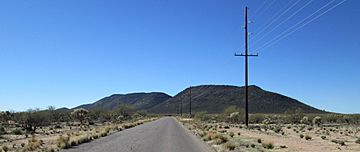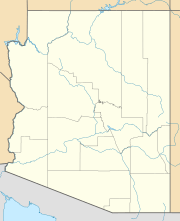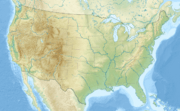Black Mountain (Pima County, Arizona) facts for kids
Quick facts for kids Black Mountain |
|
|---|---|

Black Mountain from the east
|
|
| Highest point | |
| Elevation | 3,700 ft (1,128 m) NAVD 88 |
| Prominence | 889 ft (271 m) |
| Geography | |
| Location | Pima County, Arizona, U.S. |
| Topo map | USGS San Xavier Mission |
Black Mountain is a special kind of flat-topped mountain called a mesa in Pima County, Arizona. It gets its name because its top is covered with dark lava rock. This mountain rises about 1,000 feet (305 meters) from its base, reaching a total height of 3,700 feet (1,128 meters) above sea level.
Black Mountain is a long, narrow ridge, stretching about 5,600 feet (1,707 meters). It is located along Mission Road, about nine miles (14.5 kilometers) southwest of the city of Tucson. The mountain is part of the San Xavier Indian Reservation, and it sits about 3.18 miles (5.12 kilometers) southwest of the famous Mission San Xavier del Bac. Nearby, the Sierrita Mountains are to the southwest, and the Santa Cruz River flows about four miles (6.4 kilometers) to the east.
Ancient History of Black Mountain
Black Mountain holds secrets from a very long time ago. On its top, you can find the remains of an old fort built by the Hohokam people. The Hohokam were an ancient Native American culture who lived in the Southwest United States. They lived in this area from about 300 AD to 1500 AD.
What Can Be Seen Today
Even today, you can still see parts of this ancient site. There are long stone walls and circular stone rings. You might also spot petroglyphs, which are drawings carved into rocks. Old trails made by people long ago are also visible. Sometimes, pieces of broken pottery, called pottery sherds, can be found too. These discoveries help us learn about the people who lived here centuries ago.
Why You Can't Visit
It's important to know that this ancient site is on reservation land. This means it is private land belonging to the Tohono O'odham Nation. Because of this, the site is not open to the general public. This helps protect the important historical ruins and respects the privacy of the tribal community.



